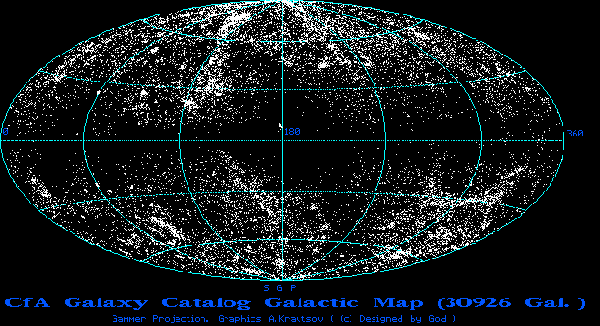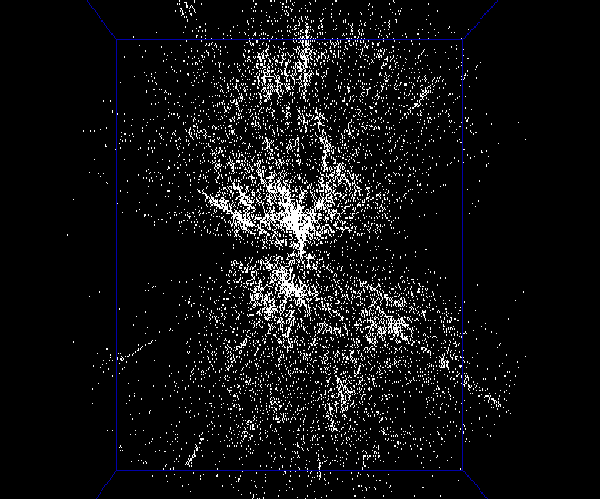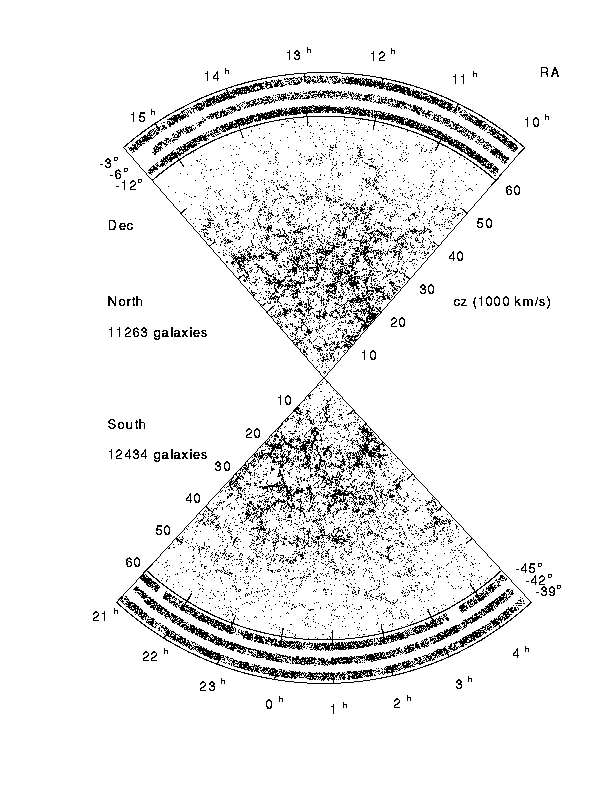Dark Matter
Dark Matter: Theory
- The need for dark matter has also been seen in theoretical models of the Universe.
In these COSMOLOGICAL MODELS, we simulate the Universe. We represent galaxies
by individual particles and then evolve them through time.
- These models provide us with additional insight about the nature of dark matter.
One of the main properties is its temperature. We simply refer to the dark matter
as either "hot", "cold", "warm", or "mixed". Mixed is dark matter that is made up of
both hot and cold material.
- The temperature of the dark matter will determine how much it will clump and
form structure. Here is a site with many
movies which show how cosmological simulations work.
Some of them are a zoom in , and
fly through . And
a cluster forming .
- Here is another simulation .
Large Scale Strucutre
- The main features of the simulations show the large scale structure of the
Universe. The plot below is an actual plot of the Universe with each point
representing a galaxy.

- The images above and below come from the CfA redshift survey (out of Harvard).
This was the first big survey and showed a variety of features: fingers of God,
The Great Wall, large voids. These data were compiled initially by two people,
Margaret Geller and John Huchra.
- The above image is a spatial projection and the image below shows a redshift slice.
A redshift slice is a plot which uses redshift as a distance indicator (which
we know that it is according to Hubble's Law). A redshift slice near a cluster
of galaxies creates the long fingers seen in the images.

- There are many ongoing surveys and one of the more recent redshift slices
shown below. This comes from the Las Companas Redshift Survey (LCRS) in Chile.
It goes out ot much higher redshifts than the previous survey. There are
a handful of surveys that are currently producing huge amounts of data. The
two largest ones are the 2DF (in Australia) and
Sloan (in New Mexico).

Dark Matter Models
- So one of the goals of the dark matter simulations is to match the distribution
of galaxies in the Universe. These must include a large volume of space to
estimate properly the structure seen.
- By far, the most popular had been cold dark matter (or CDM). For some time now
we have understood the basic properties for making structure. There has to
be enough time and mass for systems to come together.
- For example, we start the simulation with an expanding Universe filled with
hot gas and let it evolve. There are spots in the Universe that have an
over-density by random. These spots eventually come together if there is
enough mass.
- If there is not enough mass, the structure will never be able to overcome
the expansion. This result was a theoretical reason as to why we needed
dark matter: without it there was not enough structure
- The other requirement is that there has to be enough time for the structure
to form that we see today. This is way the age of the Universe is so important
for the modelers since they have to tie the age with the amount of structure.
- The history of cosmological simulations tracks very well with the improvement
of computers. Since we are trying to simulate the Universe, we need as many
particles as possible (this requires memory) and then we must be able
to track them (this requires speed).
- What is probably the most important aspect of the cosmological simulations
are the initial conditions. I.e., just how do we start the Universe model?
We said that we start with a smooth distribution of gas, and some parts of
if have over-densities. But the important question is just how over-dense
and how many of these regions are there.
- The answers lie in the cosmic microwave background.


